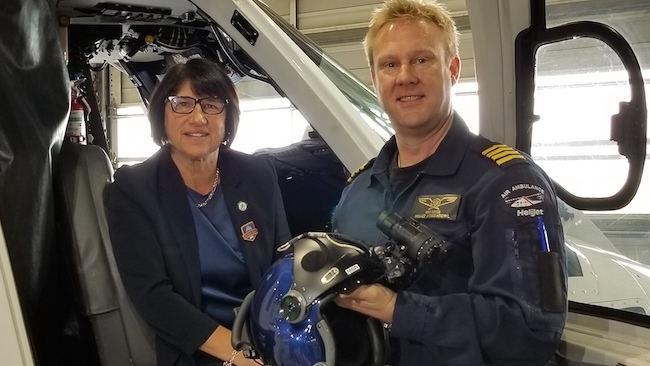
News
Helijet and BCEHS begin air ambulance patient transports using night vision technology
May 9, 2018 By Helijet
Richmond-based Helijet International Inc. and BC Emergency Health Services (BCEHS), part of B.C.’s Provincial Health Services Authority, have completed the installation of night vision imaging technology aboard all three of Helijet’s air ambulance helicopters, to safely reach communities and patients at night.

Helijet, with over 20 years of air medical operational experience, is the primary helicopter service provider for BCEHS and the installation of night vision goggles in the air ambulances is the result of a $1.7 million agreement reached with BCEHS last year. VIH Aerospace in Saanich, B.C. plus Night Flight Concepts and Rebtech, both based in Texas, were instrumental in completing the system installation, and in training Helijet’s flight and maintenance personnel.
All three of the Sikorsky S76C+ helicopters are currently based at Helijet’s base at YVR in Richmond, but one of them will soon be repositioned to Helijet’s Prince Rupert base at Seal Cove once crew training is complete. BCEHS’ first in-service night vision patient transport took place on April 20, 2018. In the two weeks that followed, a total of 11 missions were flown using the technology.
The new system makes use of image enhancement technology capable of collecting all available light, cultural man-made and celestial (ie: space/moon) and amplifying it so that the pilot can see in the dark through a set of helmet-mounted goggles.
“This new technology will increase our operational reliability, while ensuring the safest possible flying conditions during nighttime and low-light conditions,” said Danny Sitnam, President and CEO of Helijet International. “The safety of our patients, aircrew and paramedics is paramount and this night-vision technology will allow our pilots to fly into locations where darkness or low lighting conditions have posed challenges in the past. This will maximize our mission reliability and safety for the patients and communities we serve.”
“This is an important investment to improve access to patient care in British Columbia,” said B.C. Health Minister Adrian Dix. “The addition of night vision technology also builds on recent investments we’ve made to improve access to ambulance services and will ensure a heightened level of safety for patients, flight crews and air ambulance paramedics,” said Dix.
“We’ve been working hard to enhance our air ambulance program, and night vision technology is one of the ways in which we are improving our service,” adds Linda Lupini, Executive Vice President of BCEHS and the Provincial Health Services Authority.
Approximately 2,000 patients in BC are transported by helicopter each year. About 10 per cent of all air ambulance transports are emergency 911 air ambulance responses. The vast majority of air ambulance flights in BC transfer patients from B.C.’s North and the Interior regions between hospitals and other health care facilities.
Patients in northern B.C. account for approximately 40 per cent of all air transports, and patients in the Interior account for approximately 25 per cent.